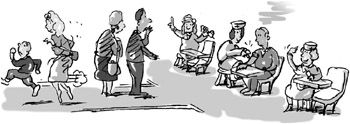Flu Math

Suppose the government health authorities tell you that you have a 5% chance of dying from a flu vaccine but a 10% chance of contracting and dying of the flu when an epidemic strikes if you don’t take the vaccine. Do you take the vaccine assuming it offers perfect protection?
Many people refuse.
This apparent irrationality is commonly attributed to “omission bias” - people tend to prefer inaction to action. But I think there are other reasons. For one thing, the authorities commonly have a bias towards action - if only to justify their own existence. If so, the consequences of the flu may be overstated or the risks of the vaccine may be understated.
But even if these probabilities are to be believed and the bias towards inaction is corrected, there is the observation that the risk of being unvaccinated decreases if most other people take the flu vaccine.
Suppose, in fact, that your likelihood of dying from the flu when unvaccinated goes down according to the following formula: If a fraction f (excluding you) of people take the flu shot, then your probability of dying from the flu is just (1-f) × 10%. For example, if 65% of the people take it and you are among the 35% who do not, then the probability of your contracting the flu is 0.35 × 10% = 3.5%.
Warm-Up
Suppose a government official could require 60% of the people to take the vaccine. Then what would be the average risk of death for the entire population due to the flu?
Solution to Warm-Up
Recall that if the official doesn’t allow anyone to take the vaccine, then the death toll is 10%. If the official forces everyone to take it, the death toll is 5%. If 60% take the shot, then those people have a 5% chance of dying, but the others have only a 40% chance of dying from the flu, so the death toll among them is 4%. The overall death toll, therefore, is (0.6 × 5%) + (0.4 × 4%) = 4.6%.
-
As long as the government is in a compelling mode, what fraction should be required to take the vaccine in order to minimize the overall average risk?
On the other hand, suppose that the government feels it cannot (or, preferably, should not) compel people to take the vaccine. Instead, the government offers each person the flu shot in turn. If a person refuses, then there is no second chance. Each person knows how many people took the flu shot among those already offered. Each person believes and knows that everyone else believes the government’s risk figures (5% if a person takes it; 10% modified by the f formula above if a person doesn’t). Each person will take the flu shot if and only if it helps him or her. There is no regard for the greater good.
-
Under these conditions (no compulsion, full belief in government risk figures, selfishness), what percentage of people will take the flu shot?
-
Suppose 25% of the population will not take the vaccine under any circumstances. Nobody else knows beforehand who they are. Then can you determine what percentage of people will in fact take the vaccine under the same assumptions?
The government looks at these results and decides that a little benevolent disinformation is in order. That is, the government will inflate the risk of disease to a number R greater than 10% but with the risk of contracting the flu if one is unvaccinated decreasing based on the f formula, with the 10% replaced by R - that is, (1-f) × R. The exaggerated risk strategy is a carefully guarded secret, so everyone believes the government and knows that everyone else does too.
-
Again, the government will compel nobody. To which percentage should the risk of disease be inflated to achieve the vaccination level you determined in your answer to question 1?
Disclaimer: The actual death rates from the flu and flu vaccines are typically far smaller than the numbers used in these examples. Also, the scenario of benevolent disinformation is purely invented. Purely.
EAN: 2147483647
Pages: 81